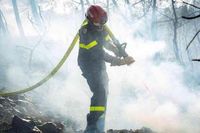The southern French department of Aude, famed for its rolling vineyards and sleepy villages, has been thrust into the global spotlight for all the wrong reasons. In early August 2025, the region became the site of France’s largest wildfire in at least half a century, a disaster that has left scars both physical and emotional on the land and its people. The scale and intensity of the blaze have stunned even seasoned firefighters, as communities across the Mediterranean basin grapple with a summer marked by unprecedented heat and relentless flames.
According to reports from Agence France-Presse and the Associated Press, the fire erupted in the Corbières mountain region, a picturesque area known for its wine country, on Tuesday, August 5, 2025. Fanned by hot, dry winds and temperatures soaring above 40 degrees Celsius (104 Fahrenheit), the flames tore through more than 16,000 hectares (62 square miles) of vegetation in just three days. The disaster quickly eclipsed previous records, with France’s minister for ecological transition, Agnès Pannier-Runacher, describing it as "the worst since 1949" and linking its ferocity to climate change.
By the weekend, authorities announced the fire was contained, but not yet under full control. Christophe Magny, chief of the region’s firefighter unit, cautioned, "The fire is contained but ... until Sunday evening the fire will not be under control." The situation remained volatile, with forecasts predicting the return of the notorious tramontane—a northerly wind infamous for whipping up flames—and another punishing heatwave. Helene Sandragne, president of the Aude departmental council, told AFP, "The firefighters will do their utmost before the return of the tramontane this weekend."
Tragically, the blaze claimed the life of a 65-year-old woman in Saint-Laurent-de-la-Cabrerisse, who was found dead in her home on Wednesday, August 6. The toll didn’t end there: at least 21 others were injured, including 16 firefighters, with one resident suffering serious burns and several others sustaining lighter injuries. Nineteen firefighters were hurt over the course of the operation, one with a head injury.
The fire’s impact on local communities has been profound. About 2,000 people were evacuated at the height of the crisis, though some were allowed to return by Friday evening, August 8. Still, as of Friday morning, nearly 1,000 residents had not yet been able to go home, with many roads blocked and 1,300 homes left without electricity due to extensive damage to infrastructure. Emergency shelters sprang up across 17 municipalities, providing refuge to those displaced.
In the village of Tuchan, Mayor Beatrice Bertrand described a night of chaos and solidarity: "We have received and hosted over 200 people. We gave them food, thanks to local businesses who opened their stores despite it being very late. Civil Protection brought us beds. And also the local villagers offered their homes to welcome them. It was their first night here and many were shocked and scared." Her words capture both the anxiety and the extraordinary resilience of the community.
Elsewhere, the fight against the flames was even more desperate. Paulette Ricard, a resident of the hamlet of Coustouge, recounted, "The village was surrounded by fire. Flames all around us. There was only one fire truck." Ricard and her family spent the night dousing small blazes in gardens and orchards with little more than garden hoses and stored rainwater, waiting for help to arrive.
Firefighting teams, numbering more than 1,400 at the peak, deployed every tool at their disposal. Remi Recio, deputy prefect of Narbonne, explained, "We are watching very carefully the hot spots. With that, we’re able to detect with precision the potential places for reignition." Crews used thermal drones and GPS mapping to monitor for flare-ups, while authorities launched an investigation into the fire’s cause.
The devastation was not limited to the natural landscape. The fire swept through 15 communes, destroying or damaging at least 36 homes. The wine country’s famed vineyards, in some cases, acted as natural firebreaks, leaving behind a surreal patchwork of scorched earth and untouched green vines—a stark visual reminder of both loss and survival.
The crisis in Aude unfolded alongside similar catastrophes across the Mediterranean. Wildfires forced evacuations near Athens, Greece, where one man died during an evacuation southeast of the capital. In northern Turkey, authorities evacuated a university campus and an elderly care home, and temporarily suspended maritime traffic through the Dardanelles Strait due to thick smoke. The Mediterranean basin, it seems, has become a tinderbox this summer.
Scientists and officials are increasingly direct in their assessment of the underlying causes. As AP and AFP both report, experts say that intensifying summer heatwaves linked to global warming are making European countries ever more vulnerable to such disasters. The European Union’s Copernicus Climate Change Service notes that Europe is the world’s fastest-warming continent, with temperatures rising at twice the global average since the 1980s. Last month, a wildfire near Marseille left around 300 people injured, further underscoring the mounting crisis.
The response to the Aude fire has been a testament to both the professionalism of emergency services and the solidarity of local communities. More than 1,000 personnel remained deployed in the fire zone as of Friday, August 8, 2025, working around the clock to secure the area and prevent new outbreaks. Residents have been repeatedly warned not to return home without authorization, as many roads remain hazardous and hot spots could reignite at any moment.
Despite the challenges, there have been moments of hope. As authorities gradually allowed some evacuees to return, the sense of relief was palpable—though tempered by the daunting task of rebuilding. The investigation into the fire’s origins continues, with officials determined to learn lessons from this unprecedented disaster.
Looking ahead, the Aude wildfire stands as a stark warning. As climate change accelerates, the risk of such catastrophic events only grows. For the communities of southern France, the summer of 2025 will not soon be forgotten—a season when the land burned, but the spirit of its people endured.




